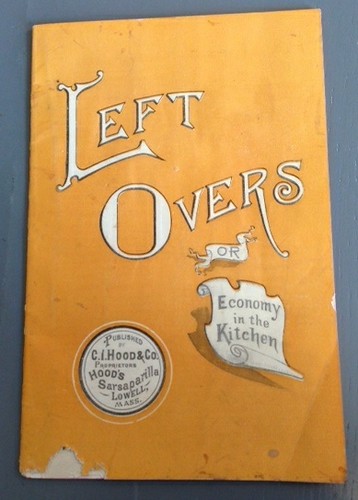I’ve been doing some reading on leftovers lately, and yesterday I read this beauty:
It’s part leftover advice book, part advertorial for Hood’s Sarsaparilla, a cure for all that ailed folks in 1891.
It’s quite a combination, and the two topics are interspersed throughout the 17-page booklet. So after some helpful advice on using stale bread, you’ll get a testimonial from a Civil War amputee on how Sarsaparilla headed his wound. Fascinating stuff, and it makes me at least want to drink the bastardized soda.
Anyway, the content (and prose) on leftovers is as interesting as the editorial combination. For example, there’s this handy list of uses for sour milk: biscuits, gems, corncakes, shortcakes rye muffins, doughnuts, gingerbread, griddle cakes, cookies, cakes and cottage cheese.
Meanwhile, I learned that brewis is milk-soaked bread crumbs usually cooked with fish that likely tastes like frugality. And I found out that there are a baked good called gems that remain a mystery.
And speaking of gems, I find this one inspiring and useful:
One is often puzzled to think of ways of using the whites or yolks of eggs left over when the other part has been used. In making…dishes requiring only the yolks, plan to make at the same time either a white or snow cake, apple snow, charlotte ruse, meringues, pudding sauces, cream whips, frosting for cakes, maccaroons or cocoanut [sic] cakes what will use up the whites.
By the way, you really should try my charlotte ruse–it’s quite clever!


 By just about any indication, it was a great day for food waste awareness. To hear the Secretary of Ag utter the words “…too much of [our] food goes to waste” was nearly unthinkable five years ago. And then to have the head of the EPA utter the 40 percent waste figure was equally exciting.
By just about any indication, it was a great day for food waste awareness. To hear the Secretary of Ag utter the words “…too much of [our] food goes to waste” was nearly unthinkable five years ago. And then to have the head of the EPA utter the 40 percent waste figure was equally exciting. This is exciting mostly because of the potential scale of that spreading. If Kroger’s decisionmakers decided build biogas systems nationwide, that could mean AD at 2500 stores in 31 states. Even having systems only at regional distribution centers–more likely–would be huge.
This is exciting mostly because of the potential scale of that spreading. If Kroger’s decisionmakers decided build biogas systems nationwide, that could mean AD at 2500 stores in 31 states. Even having systems only at regional distribution centers–more likely–would be huge. The campaign, in conjunction with the EPA, will challenge food producers, manufacturers and retailers–really everyone involved in the food chain–to reduce their food waste, recover excess food to feed those in need and recycle the inedible remains. Let’s hope the main focus is on reducing waste!
The campaign, in conjunction with the EPA, will challenge food producers, manufacturers and retailers–really everyone involved in the food chain–to reduce their food waste, recover excess food to feed those in need and recycle the inedible remains. Let’s hope the main focus is on reducing waste!